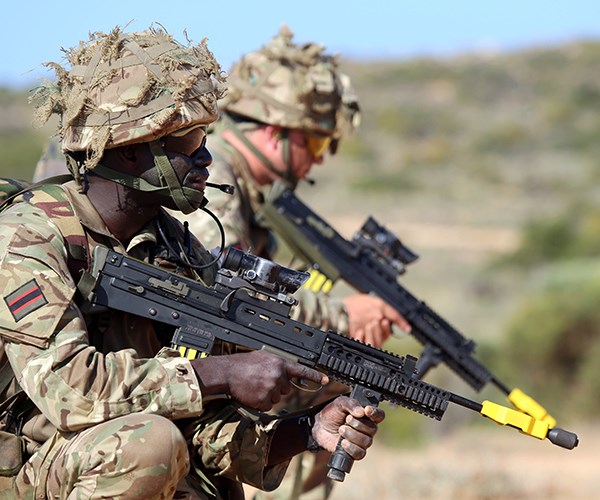The famous infantry regiment, The Rifles, is the biggest Regiment in the British Army. It has a vast collection of parent regiments, and now consists of five Regular and three Reserve battalions, plus a number of companies in other Army Reserve battalions, making it not only one of the most influential regiments on the battlefield but also giving it a deep and wide breadth of history. Here are ten things you might not have known about it:
1) The Rifles are located in such a way in order to serve a whopping 13 counties across England; Berkshire, Buckinghamshire, Cornwall, Devon, Dorset, Durham, Gloucestershire, Herefordshire, Oxfordshire, Shropshire, Somerset, South Yorkshire and Wiltshire.
 |
| Soldiers from The Rifles on Parade |
2) All eight battalions amalgamated from a total of 5 previous regiments, including the Royal Green Jackets (RGJ) and the Royal Gloucestershire, Berkshire and Wiltshire Light Infantry (RGBWLI). 22 previous regiments made these final 5 and only started merging in 1881.
3) Due to the scale of The Rifles, 7 battalions have Royal Colonels with the 8th Battalion’s Colonel yet to be announced.
 |
| HRH The Countess of Wessex inspecting 5th Battalion The Rifles, of which she is Royal Colonel |
4) Not only are the battalions a ‘melting pot’ of former regiments, but so is the Band and Bugles of The Rifles. This was made from the remnants of the Band and Bugles of the Light Division, itself made from 4 bands: The Corunna Band of the Light Infantry, The Salamanca Band of the Light Infantry, The Peninsula Band of the Royal Green Jackets and The Normandy Band of the Royal Green Jackets. The 6th and 7th reserve Battalions have their own bands, formerly from the Rifle Volunteers Regiment. The Bugle Horn is also of special significance to The Rifles because it emerged from the light troops of the British Army in North America and Europe who used new tactics over greater distances, making the drum inadequate as a means of communication. The Bugle Horn, easily carried and penetrating in sound, was the ideal replacement and by 1800 “field sounds” were used across all of the Light Companies. The Regiment’s connection to the bugle continues today, not only as of the cap badge but also within the band and daily battalion life.
 |
| The cap badge of The Rifles, bearing the image of a Bugle |
5) The alternate spelling of sergeant as "serjeant" is used in The Rifles as they draw their heritage from the Oxford and later Bucks Light Infantry. It was thought that using the “J” allowed the regiment to retain its links to the Light Infantry and RGJ regiments. Its origin is the Latin "serviens", "one who serves", through the French term "sergent".
6) The Rifles hold a record number of battle honours, all from its parent regiments. Since The Rifles was only formed in 2007, their last inherited honour was Iraq 2003. The Rifles itself has never gained a battle honour. 34 of the battle honours they hold are inscribed on their belt badge, and therefore it is entrusted to each rifleman to protect these, as they do not have any regimental colours.
7) For their gallantry fighting during the Battle of Alexandria 1801, the RGBWLI regiment was given the unique honour of wearing a Back Badge with the word “Egypt” inscribed below a sphinx, at the back of their caps. This honour has prevailed. On the 1st February 2007, Royal Gloucestershire, Berkshire and Wiltshire Light Infantry merged with the Devonshire and Dorset Light Infantry, to become 1 Rifles. The regular battalions of the Rifles wear the Back Badge with their ceremonial dress, and officers and warrant officers wear it on side hats. The Back Badge is also worn by the Band and Bugles of The Rifles on the ‘shako’.
8) The Sounding Retreat is a form of the Beating Retreat, except played by the Band and Bugles of The Rifles. This traditional ceremony (which represents the sounding of Sunset or Retreat in the British Army) has been done on 31 May and 1 June on Horse Guards Parade as recently as 2016.
 |
| Soldiers from 1 RIFLES on exercise |
9) Regimental records of the 60th (Kings Royal Rifle Corps) Rifles state that Major-General James Wolfe was so impressed with the alertness, intrepidity and spirited conduct of the grenadier companies of the 2nd and 3rd Battalions of the 60th Royal Americans before Quebec in that he conferred on them the motto Celer et Audax (translating from Latin as ‘Swift and Bold’). The exact occasion of this is not certain. Most probably it was on 9 August 1759 when it is believed that the grenadier companies, who were escorting Wolfe at the time, had a sharp encounter with the enemy and that he was extremely pleased with the outcome. The motto to this day for The Rifles is “Swift and Bold”.
10) When bringing troops properly At Ease, the command “ATTENTION!” is never used. Instead, the command “STAND READY!” is called, in contradiction to most other regiments.

Comments
Post a Comment